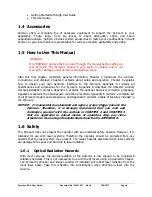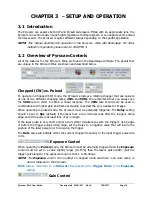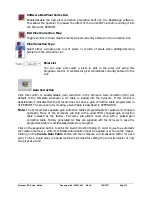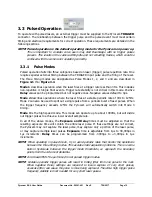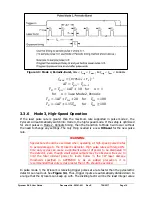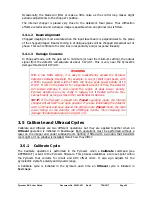
Pyrocam III
HR
User Guide
Document No. 50361-001
Rev E
7/18/2017
Page 15
3.3
Pulsed Operation
To operate with pulsed lasers, an external trigger must be supplied to the Pyrocam
TRIGGER
connector. The relationship between the trigger pulse and the pulsed event must meet certain
timing and electrical requirements for correct operation. These requirements are detailed in the
following sections.
NOTE:
Pulsed operation is the default operating mode for the Pyrocam on power up
.
This is important to consider since users may start BeamGage with no trigger pulses
present. This results in the camera sitting idle and not collecting frames, which could be
confused with the camera not operating correctly.
3.3.1
Pulse Modes
Pulsed operation falls into three categories based on laser (trigger) pulse repetition rate. One
requires special external timing between the TRIGGER input pulse and the firing of the laser.
The three timing modes are designated as Pulse Modes 1, 2, and 3 and are described in
Mode 1
describes operation when the laser fires at a trigger rate less than 3Hz. This includes
non-repetitive or Single Shot events. Trigger rate stability is not critical in this mode. Positive
Delay
values can be programmed but not negative ones. Negative values default to 0µs.
Mode 2
describes operations where the laser fires at a stable periodic rate of 3Hz to 125Hz.
Mode 2 can also be used to split out a single pulse from a periodic burst of laser pulses. When
the trigger frequency exceeds 125Hz the Pyrocam will automatically switch into Mode 3
timing.
Mode 3
is the high speed mode. This mode can operate up to about 1000Hz, but will divide
out trigger pulses to achieve a lower overall sample rate.
In all of the above modes, the
Exposure and Delay
times must be adjusted so that the
resulting exposure time will contain the entire laser pulse. If these settings are not correct,
the Pyrocam may not capture the laser pulse, may capture only a portion of the laser pulse,
or may capture multiple laser pulses.
Exposure
time is adjustable from 1µs to 40,000µs in
1µs increments.
Delay
times can be programmed from -3000µs to +3,000µs in 1µs
increments.
NOTE:
When operating in pulsed mode, try to avoid periodic rates that border the transitions
between the three timing modes. This avoids erratic acquisition problems. There is some
built-in hysteresis between the trigger mode thresholds, so approach the boundary
points from the side most desirable.
NOTE:
An Ultracal MUST be performed for all pulsed trigger modes.
NOTE
: Unstable periodic trigger pulses will result in timing jitter from one pulse to the next.
When negative Delay settings are required to insure capture of very short pulses,
excessive jitter can cause the pulse to miss being captured. Therefore high trigger pulse
frequency stability is most needed for very short laser pulses.






